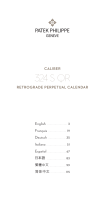La page est en cours de chargement...

English
Français
Deutsch

English

Introduction
This wristwatch unites two complications
consummately mastered by Patek Philippe: a
perpetual calendar and a minute repeater. The
self-winding movement with a strike train em-
bodies all functions of a full calendar as well as
a moon-phase display. The Ref. 5074 stands out
with remarkable sonority. Patek Philippe devo-
ted considerable resources to metallurgical and
acoustic research with the aim of crafting gongs
that produce an incomparably pure sound.
The minute repeater
On demand, the minute repeater strikes the hours,
the quarter-hours, and the minutes that have elapsed
since the last quarter-hour. One hammer strikes the
hours on the low-pitched gong once for each hour.
Subsequently, each quarter-hour is sounded as an
alternating double strike by two hammers on both
the high- and low-pitched gongs. Finally, the second
hammer strikes the high-pitched gong to count the
number of minutes that have passed since the last
quarter-hour.
12 low strikes, three double high-low strikes, 14 high
strikes: This constitutes the melody with a total of
32 strikes at 12:59.
Reference 5074
Caliber R 27 Q
Self-winding wristwatch with
minute repeater and perpetual calendar.

The “cathedral” gongs
To optimize the acoustic quality of a minute-
repeater wristwatch, the “cathedral” gongs are
shaped to encircle the movement not just once,
but nearly twice. This makes them almost twice
as long as conventional gongs. The result: greater
vibrational stability and better acoustic charac-
teristics.
The perpetual calendar
The perpetual calendar indicates the date, the day
of the week, the month, and the leap-year cycle,
automatically taking into account months with
28, 29, 30, and 31 days. It switches directly from
September 30 to October 1 or from February 28
to March 1. In leap years, it indicates February 29
before switching to March 1.
If the watch is worn regularly or kept in a winder,
the perpetual calendar mechanism will require
no manual correction until February 28, 2100, a
secular year in which, as an exception, February
29 is skipped.
Displays, functions, and correctors
DISPLAYS AND FUNCTIONS
1- YEAR (4 = LEAP YEAR)
2- MONTH
3- MOON PHASE
4- CALENDAR (DATE)
5- 24-HOUR DIAL
6- DAY OF THE WEEK
7- MANUAL WINDING
8- SETTING THE TIME
9- SLIDE FOR ACTUATING THE MINUTE REPEATER
CORRECTORS
A- CALENDAR CORRECTION PUSH PIECES: DATE (4), MONTH (2), YEAR (1)
B- CORRECTION PUSH PIECES FOR THE MONTH (2) AND THE YEAR (1)
C- MOON-PHASE CORRECTION PUSH PIECE (3)
D- DAY-OF-WEEK CORRECTION PUSH PIECE (6)
• PLEASE PERFORM ALL SETTINGS AND ADJUSTMENTS WITH THE CORRECTION STYLUS THAT WAS DELIVERED WITH YOUR
WATCH. THE USE OF ANY OTHER TOOL COULD DAMAGE YOUR WATCH.
• DATE AND MOON PHASE CORRECTIONS MUST BE MADE AT 7 AM. THIS IS THE ONLY WAY TO ASSURE THAT THE DATE CHANGE
MECHANISMS ARE NOT ENGAGED AND CANNOT BE DAMAGED.
• THE SETTING SEQUENCE DESCRIBED BELOW MUST BE STRICTLY OBSERVED.
NOTE ON CORRECTING PERPETUAL CALENDAR DISPLAYS (PUSH PIECE A) AND MOON PHASE DISPLAY (PUSH PIECE C):
9
A B 1 2
D78
C3456

Settings
SETTING THE CALENDAR DISPLAYS
PREPARATIONS PRIOR TO SETTING
SETTING THE MOON PHASE
• Before performing any corrections or settings,
always wind the watch (20 turns of the winding crown).
• Pull the crown (8) out.
• Advance the hands clockwise until the day-of-week
hand (6) and the date hand (4) switch forward by one day.
• Set the hands to 7 am.
• Push the winding crown (7) home again.
• Actuate the correction push piece (A) as many times as
needed to align the date hand (4) with the current date.
• Actuate the correction push piece (B) as many times as
needed to indicate the correct year (1) (2014 = II; 2015
= III; 2016 = leap year IV) and then the current month
(2).
• Actuate the correction push piece (D) as many times as
needed to display the current day of the week (6).
• Actuate the correction push piece (C) as many times as
needed to display the full moon in the moon-phase
aperture (3).
• Consult the “Full Moon Calendar” annexed to these
instructions to find out how many days have elapsed
since the last full moon and actuate the correction push
piece that many times (without the day of the last full
moon).
A B 2
D
C
4
4
6
6
8
7

Minute repeater
The strike sequence of the minute repeater
must be allowed to end completely before it
is activated again.
Caution: Under no circumstances should you
manipulate the winding crown while the mi-
nute repeater is striking the time and during
30 seconds thereafter. Doing so could cause
damage to the repeating mechanism which
would not be covered by the warranty. To acti-
vate the striking mechanism, push the slide (9) all
the way up.
Now release it completely - do not pull it down.
Two small hammers will now strike the hours,
quarter-hours, and minutes on two gongs of low
and high pitch.
If the watch was set aside unwound for an ex-
tended period of time, the minute repeater might
not indicate the correct time because the oil may
have thickened at some points inside the mecha-
nism. This is absolutely normal and has no negative
consequences. The striking mechanism will func-
tion correctly again within one to two hours after
the watch has been rewound.
Recommendations
WATER RESISTANCE
Although your watch is equipped with seals for
the crown, it is not protected against the ingress
of moisture because of the slot for the minute
repeater slide.
Therefore, exercise care to ensure that liquid does
not come into contact with your watch.
HAVING YOUR WATCH SERVICED
We recommend that you have your watch ser-
viced at least once every three to five years. For
this purpose, we suggest you take it to an Au-
thorized Patek Philippe Retailer who will send
it to our Geneva manufacture, the only location
authorized to service watches with minute re-
peaters. You can then be assured that your watch
will be inspected and overhauled by a qualified
master watchmaker at Patek Philippe headquar-
ters in Geneva.
The master watchmaker will completely disassemble
the movement and then inspect, clean, and lubri-
SETTING THE TIME
• Pull the crown (8) out.
• Set the hands to the correct time. If you advance the hands
beyond midnight, all displays of the perpetual calendar will be
advanced as well.
• After having set the time, push the crown (7) home again.
8
7
9

cate all the individual parts prior to reassembly.
All functions of the watch will also be tested in
detail and the escapement regulated if necessary.
Finally, its rate accuracy will be monitored and
precision-adjusted for a further period of at least
two weeks.
The case and the buckle will be polished as per
your instructions and your watch will be returned
to you in mint condition. The entire process may
take several weeks because each watch must un-
dergo a complete series of tests to fulfill the strict
quality criteria of Patek Philippe.
If you have any questions regarding the main-
tenance of your watch, contact the Authorized
Patek Philippe Retailer nearest you or our Inter-
national Customer Service department in Geneva,
or visit www.patek.com.
WINDING
Your watch is wound automatically by the move-
ments of your wrist, which set a winding mecha-
nism in motion. When fully wound and off the
wrist, you watch has a power reserve of at least
38 hours. If it was set aside for a longer period of
time and is no longer running, it can be manually
wound with about ten turns of the crown.
We advise you to wind the watch before you put
it on. This way, you can avoid lateral pressure on
the winding stem which in the course of the years
could damage the stem tube.
The same applies to handsetting. Please use your
fingernails to pull the crown out and turn it gently
between two fingertips.
WATCH WINDER
Your Ref. 5074 is delivered with a winder. Keep
your watch in this box if you intend not to wear
it for a longer period of time. The rotation of the
watch holder will keep it wound and you will not
have to reset the time when you put your watch
on again.
Within 24 hours, the winder will move your watch
during 8 hours and let it rest for 16 hours.
PATEK PHILIPPE SEAL
As a comprehensive seal of quality, the Patek Phi-
lippe Seal applies to the entire watch, including the
movement, case, dial, hands, pushers, strap, and clasp
as well as to all other facets that contribute to the
precision and visible appearance of the timepiece. Its
applicability to the technical, functional, and aesthe-
tic aspects of the watch takes into consideration not
only the artisanship with which it was crafted, but
also covers its rate accuracy, its dependability, and
the quality of customer service. Moreover, it stands
for the entire know-how and all the special skills
invested in the development, production, and long-
term maintenance of an extraordinary timepiece.
CHANGING THE CASE BACK
Your watch comes with a sapphire-crystal case
back as well as with an interchangeable solid-me-
tal back. Only qualified master watchmakers at the
Patek Philippe workshops in Geneva are authorized
to exchange the backs.

CALIBER: R 27 Q
DIAMETER: 28 MM
HEIGHT: 6.80 MM
NUMBER OF PARTS: 467
NUMBER OF JEWELS: 39
WINDING ROTOR: GUILLOCHED 22K GOLD MINIROTOR,
UNIDIRECTIONALLY WINDING
POWER RESERVE: MIN. 38 HOURS - MAX. 48 HOURS
BALANCE: GYROMAX®
FREQUENCY: 21,600 SEMI-OSCILLATIONS PER HOUR (3 HZ)
BALANCE SPRING: FLAT
HALLMARK: PATEK PHILIPPE SEAL
Specifications of the movement

Français

Introduction
Les deux complications que Patek Philippe maî-
trise en virtuose – le quantième perpétuel et
la répétition minutes – sont réunies dans cette
montre-bracelet. Elle associe un mouvement au-
tomatique à répétition minutes, toutes les fonc-
tions du quantième perpétuel ainsi que les phases
de lune. Un son d’une qualité exceptionnelle dis-
tingue la référence 5074. Il a fallu à Patek Philippe
pousser très loin ses recherches en métallurgie
et en acoustique pour obtenir ce timbre parfait,
d’une pureté sans égale.
La répétition minutes
La répétition sonne sur demande les heures, les
quarts, ainsi que les minutes écoulées depuis le der-
nier quart. Le premier marteau sonne les heures en
frappant un coup par heure écoulée sur le timbre
grave. La sonnerie des quarts est ensuite assurée par
deux marteaux qui frappent alternativement sur le
timbre aigu puis sur le timbre grave. Le deuxième
marteau vient ensuite frapper, sur le timbre aigu, le
nombre de minutes écoulées depuis le dernier quart.
12 coups graves, 3 doubles coups, 14 coups aigus: ainsi
se fait entendre le son mélodieux de 12 heures 59
minutes (totalisant le maximum de 32 coups).
Référence 5074
Calibre R 27 Q
Montre-bracelet répétition minutes,
quantième perpétuel, à remontage automatique.

Les timbres «cathédrale»
Afin d’enrichir encore davantage l’acoustique
des montres-bracelets à répétition minutes, les
timbres «cathédrale» sont disposés autour du
mouvement non pas sur une seule circonférence
mais sur presque deux. Ainsi, ils sont environ
deux fois plus longs que les timbres usuels et of-
frent une stabilité de vibration optimale de même
que des propriétés acoustiques améliorées.
Le quantième perpétuel
Le quantième perpétuel indique le jour, la date
et le mois en prenant automatiquement en
compte les mois de 28, 29, 30 et 31 jours passant
par exemple, directement du 30 septembre au 1er
octobre ou du 28 février au 1er mars.
Lors des années bissextiles, l’aiguille de quan-
tième affiche le 29 février avant de sauter directe-
ment au 1er mars.
Si la montre est régulièrement portée ou placée
dans un écrin rotatif, donc si la montre ne s’arrête
pas, le mécanisme de quantième perpétuel fonc-
tionnera sans réajustement jusqu’au 28 février de
l’an 2100, année séculaire où le calendrier grégo-
rien supprime exceptionnellement le 29 février.
Indicateurs, fonctions et corrections
INDICATEURS ET FONCTIONS
1- ANNÉE (IV= ANNÉE BISSEXTILE)
2- MOIS
3- PHASE DE LUNE
4- QUANTIÈME (DATE)
5- INDICATION 24 HEURES
6- JOUR
7- REMONTAGE MANUEL
8- MISE À L’HEURE
9- VERROU POUR DÉCLENCHEMENT DE LA SONNERIE
CORRECTIONS
A- CORRECTEUR DE QUANTIÈME: DATE (4), MOIS (2), ANNÉE (1)
B- CORRECTEUR DU MOIS (2) ET L’ANNÉE (1)
C- CORRECTEUR DE LA PHASE DE LUNE (3)
D- CORRECTEUR DU JOUR (6)
• AFIN D’ÉVITER D’ENDOMMAGER VOTRE MONTRE, VEUILLEZ RÉALISER TOUS LES RÉGLAGES OU CORRECTIONS EN
ACTIONNANT LES CORRECTEURS À L’AIDE DU CRAYON DE FONCTION LIVRÉ AVEC LA MONTRE. TOUT AUTRE OUTIL RISQUE
D’ENDOMMAGER LA PIÈCE.
• IL EST IMPÉRATIF D’EFFECTUER LE RÉGLAGE DE LA DATE ET DES PHASES DE LUNE À 7 HEURES DU MATIN, CECI AFIN QUE LES
MÉCANISMES DE CHANGEMENT DE DATE SOIENT DÉSENGAGÉS ET ÉVITER AINSI TOUTE DÉTÉRIORATION.
• IL EST INDISPENSABLE DE RESPECTER L’ORDRE CHRONOLOGIQUE DES OPÉRATIONS TEL QUE DÉCRIT CI-DESSOUS.
AVERTISSEMENTS CONCERNANT LA CORRECTION DES INDICATIONS DU QUANTIÈME PERPÉTUEL (CORRECTEUR A) ET DE
LA PHASE DE LUNE (CORRECTEUR C) :
9
A B 1 2
D78
C3
456

Réglages
RÉGLAGE DU QUANTIÈME
PRÉPARATION AUX RÉGLAGES
RÉGLAGE DE LA PHASE DE LUNE
• Effectuez un remontage manuel avant toute correction
ou manipulation (20 tours de couronne).
• Tirez la couronne de remontoir (8).
• Tournez les aiguilles dans le sens horaire jusqu’à ce que
l’indicateur de jour (6) et de quantième (4) avance d’un jour.
• Placez les aiguilles sur 7h du matin.
• Repoussez la couronne de remontoir (7).
• Appuyez sur le correcteur (A) afin que l’indicateur de
quantième (4) se positionne sur la date désirée.
• Appuyez sur le correcteur (B) jusqu’à l’affichage désiré
de l’année (1) (2014 = II ; 2015 = III ; 2016 = année
bissextile IV) puis du mois (2).
• Appuyez sur le correcteur (D) jusqu’à l’affichage du jour
désiré (6).
• Appuyez sur le correcteur (C) afin de faire avancer le
disque lunaire (3) jusque sous sa forme pleine.
• Consultez le livret « Full Moon Calendar » remis avec ce
document pour déterminer le nombre de jour écoulés
depuis la dernière pleine lune et effectuez la correction
nécessaire (1 pression par jour écoulé, sans inclure le
jour de la dernière pleine lune).
A B 2
D
C
4
4
6
6
8
7

Répétition minutes
Veuillez attendre que la répétition ait fini de
sonner avant de l’actionner à nouveau.
Attention: veillez à ne manipuler en aucun cas
la couronne de remontoir pendant le fonc-
tionnement de la sonnerie, ainsi que pendant
les 30 secondes suivantes. Vous risqueriez
de causer au mécanisme de la sonnerie des
dommages qui ne seraient pas couverts par la
garantie. Si vous désirez armer le mécanisme de
sonnerie, poussez le verrou de déclenchement (9)
vers le haut jusqu’à sa butée. Relâchez-le sans le
maintenir ni accompagner son retour.
Deux petits marteaux sonneront sur deux timbres,
au son grave et aigu, les heures, les quarts et les
minutes.
Après un arrêt prolongé du mouvement, il se peut
que la sonnerie n’indique pas l’heure juste. Il s’agit
d’un phénomène normal sans conséquences, les
huiles ayant pu figer certaines parties du méca-
nisme. La sonnerie fonctionnera à nouveau correc-
tement au bout de quelques dizaines de minutes.
Recommandations
ETANCHÉITÉ
Même si votre montre est équipée d’une cou-
ronne étanche et d’un micro-joint de fond, le
mécanisme du verrou de sonnerie ne permet pas
une protection totale contre l’humidité.
Veillez donc à ce qu’aucun liquide n’entre en
contact avec votre montre.
ENTRETIEN
Nous vous recommandons de faire entretenir votre
montre au moins une fois tous les trois à cinq ans. Nous
vous suggérons pour cela de la remettre à un agent
agréé Patek Philippe qui se chargera de l’envoyer à
Genève où sont exclusivement entretenus les
montres à répétition minutes. Vous serez ainsi as-
suré que votre montre sera contrôlée par un maître
horloger qualifié chez Patek Philippe, à Genève. Le
maître horloger démontera complètement le mou-
vement, nettoiera tous ses composants, le vérifiera et
RÉGLAGE DE L’HEURE
• Tirez la couronne de remontoir (8)
• Tournez les aiguilles jusqu’à l’affichage de l’heure désirée. Si
vous avancez votre montre de vingt-quatre heures, toutes les
indications fournies par le quantième perpétuel seront
modifiées en conséquence.
• Repoussez la couronne de remontoir (7) après les réglages.
8
7
9

le lubrifiera lors de son remontage. Après avoir testé
le bon fonctionnement de la montre et procédé, si
nécessaire, au réglage de l’échappement, il gardera
la montre au moins deux semaines supplémentaires
afin d’en régler la marche. Le boîtier et la boucle se-
ront polis à votre convenance et votre montre vous
sera retournée en parfait état. L’ensemble du service
peut prendre plusieurs semaines, car il dépend de la
procédure de tests complète établie pour répondre
aux normes de qualité Patek Philippe.
Pour toute question concernant l’entretien de votre
montre, vous pouvez prendre contact avec nos
distributeurs, notre Service Clients International à
Genève, ou consulter notre site internet www.patek.com.
REMONTAGE
Ce sont les actions du poignet qui arment le sys-
tème de remontage de votre montre automatique.
Hors poignet et complètement remontée, elle bé-
néficie d’une réserve de marche de 38 heures mini-
mun. Si, pour être restée trop longtemps au repos,
votre montre s’est arrêtée, il convient de la remonter
manuellement en donnant environ 10 tours de couronne.
Il est préférable de remonter votre montre hors
poignet, afin de ne pas exercer sur la couronne
des pressions latérales qui, répétées au fil des
années, risqueraient d’endommager le tube de la
couronne de remontoir.
Il en est de même pour la mise à l’heure pour
laquelle nous vous recommandons de n’utiliser
que deux doigts et de faire levier avec l’ongle
pour tirer le remontoir.
ECRIN ROTATIF
Votre montre référence 5074 est livrée avec un
écrin rotatif. Si vous ne portez pas votre montre
pendant quelque temps, placez-la dans cet écrin.
Votre montre ne s’arrêtera pas grâce à la rotation
du support et vous n’aurez donc pas besoin de la
remettre à l’heure.
Sur un cycle de 24 heures, votre montre sera en
mouvement pendant 8 heures puis au repos pen-
dant 16 heures et ainsi de suite.
POINÇON PATEK PHILIPPE
Label de qualité globale, le Poinçon Patek Philippe
s’applique à l’ensemble de la montre finie, en
englobant à la fois le mouvement, le boîtier, le
cadran, les aiguilles, les poussoirs, les bracelets,
les fermoirs, ainsi que tous les autres éléments
concourant à la bonne marche ou à l’esthétique
d’un garde-temps. Couvrant à la fois les aspects
techniques, fonctionnels et esthétiques, il ne
met pas seulement en valeur la bienfacture de la
montre, mais aussi sa précision, sa fiabilité, ainsi
que la qualité du service. Il intègre par là même
tous les savoir-faire et signes distinctifs liés à la
conception, à la fabrication et à l’entretien à long
terme d’un garde-temps d’exception.
CHANGEMENT DU FOND
Votre montre est livrée avec un fond en verre saphir
et un fond plein interchangeables. Seul un maître
horloger qualifié chez Patek Philippe à Genève peut
effectuer cette opération de changement.

CALIBRE: R 27 Q
DIAMÈTRE: 28 MM
EPAISSEUR : 6.80 MM
NOMBRE DE COMPOSANTS: 467
NOMBRE DE RUBIS: 39
RÉSERVE DE MARCHE: 38 HEURES MIN. - 48 HEURES MAX.
MASSE OSCILLANTE: MINI-ROTOR EN OR 22 CARATS GUILLOCHÉ,
REMONTAGE UNIDIRECTIONNEL
BALANCIER: GYROMAX ®
FRÉQUENCE : 21 600 ALTERNANCES PAR HEURE (3 HZ)
SPIRAL: PLAT
SIGNE DISTINCTIF : POINÇON PATEK PHILIPPE
Caractéristiques

Deutsch

Einführung
In dieser Armbanduhr sind zwei Komplikatio-
nen vereint, die Patek Philippe mit höchster
Virtuosität beherrscht – der ewige Kalender
und die Minutenrepetition. Damit erhält das
automatische Uhrwerk mit Zeitschlag auch alle
Funktionen eines immerwährenden Kalenders
sowie eine Mondphasenanzeige. Die Referenz
5074 zeichnet sich durch ihre außergewöhnliche
Klangqualität aus. Patek Philippe hat langwierige
Forschung in Metallurgie und Akustik betrieben,
bis eine Tonfeder mit diesem unvergleichlich
reinen Klang gefertigt werden konnte.
Die Minutenrepetition
Die Minutenrepetition lässt auf Wunsch die
Stunden, Viertelstunden und die seit der letzten
Viertelstunde verstrichenen Minuten erklingen.
Dazu schlägt ein erstes Hämmerchen die Anzahl
Stunden auf einer tiefen Tonfeder. Danach schla-
gen zwei Hämmerchen die Anzahl Viertelstunden
durch je einen Doppelschlag auf der hohen und
der tiefen Tonfeder. Zum Schluss lässt das zweite
Hämmerchen die Anzahl der seit der letzten Vier-
telstunde verstrichenen Minuten auf der hohen
Tonfeder ertönen.
12 tiefe Schläge, drei Doppelschläge hoch-tief, 14
hohe Schläge: So erklingt die Melodie der Uhrzeit
12 Uhr 59 Minuten (mit insgesamt 32 Schlägen).
Referenz 5074
Kaliber R 27 Q
Armbanduhr mit Minutenrepetition,
ewigem Kalender und automatischem Aufzug.

Die „Kathedralen“-Tonfeder
Um die akustische Qualität einer Armbanduhr
mit Minutenrepetition zu optimieren, sind die
„Kathedralen“-Tonfedern nicht nur einmal,
sondern fast zweimal um das Uhrwerk herum
geführt. Sie sind dadurch fast doppelt so lang
wie herkömmliche Tonfedern und verfügen über
eine höhere Schwingstabilität und bessere akus-
tische Eigenschaften.
Der ewige Kalender
Der ewige Kalender zeigt den Wochentag, das
Datum, den Monat und den Schaltjahrzyklus unter
automatischer Berücksichtigung der unterschie-
dlich langen Monate mit 28, 29, 30 und 31 Tagen.
So springt er vom 30. September direkt auf den 1.
Oktober oder vom 28. Februar auf den 1. März. In
den Schaltjahren zeigt er auch den 29. Februar,
bevor er auf den 1. März wechselt.
Falls die Uhr regelmäßig getragen oder in ei-
nem Uhrenbeweger aufbewahrt wird, erfordert
der Mechanismus des ewigen Kalenders keine
manuelle Korrektur bis zum 28. Februar 2100,
einem Säkularjahr, in dem der 29. Februar aus-
nahmsweise ausfällt.
Anzeigen, Funktionen und Einstellvorrichtungen
ANZEIGEN UND FUNKTIONEN
1- JAHR (IV = SCHALTJAHR)
2- MONAT
3- MONDPHASEN
4- KALENDER (DATUM)
5- 24-STUNDENANZEIGE
6- WOCHENTAG
7- MANUELLES AUFZIEHEN
8- ZEIGERSTELLEN
9- SCHIEBER ZUM AUSLÖSEN DER MINUTENREPETITION
EINSTELLVORRICHTUNGEN
A- KALENDER-KORREKTURDRÜCKER: DATUM (4), MONAT (2), JAHR (1)
B- KORREKTURDRÜCKER FÜR DEN MONAT (2) UND DAS JAHR (1)
C- MONDPHASEN-KORREKTURDRÜCKER (3)
D- WOCHENTAGS-KORREKTURDRÜCKER (6)
• UM EINE BESCHÄDIGUNG IHRER UHR ZU VERMEIDEN, SOLLTEN SIE ALLE EINSTELLUNGEN UND KORREKTUREN MIT HILFE
JENES KORREKTURSTIFTES VORNEHMEN, DER ZUSAMMEN MIT DER UHR GELIEFERT WURDE. JEDES ANDERE WERKZEUG
KÖNNTE IHRER UHR SCHADEN ZUFÜGEN.
• DIE EINSTELLUNGEN VON DATUM UND MONDPHASEN MÜSSEN UM 7 UHR MORGENS ERFOLGEN. NUR SO IST SICHER-
GESTELLT, DASS SICH DIE MECHANISMEN ZUM DATUMSWECHSEL NICHT IM EINGRIFF BEFINDEN UND NICHT BESCHÄDIGT
WERDEN KÖNNEN.
• DIE NACHFOLGEND BESCHRIEBENE REIHENFOLGE DER EINSTELLUNGEN IST UNBEDINGT EINZUHALTEN.
HINWEIS ZUM KORRIGIEREN DER ANZEIGEN DES EWIGEN KALENDERS (KORREKTURDRÜCKER A) UND DER MONDPHASE
(KORREKTURDRÜCKER C):
9
A B 1 2
D78
C3456

Einstellungen
EINSTELLEN DER KALENDERANZEIGEN
VORBEREITUNG ZU DEN EINSTELLUNGEN
EINSTELLEN DER MONDPHASE
• Ziehen Sie vor jeder Korrektur oder Einstellung die
Uhr von Hand auf (20 Umdrehungen der Aufzugskrone).
• Ziehen Sie die Aufzugskrone (8).
• Drehen Sie die Zeiger solange im Uhrzeigersinn vorwärts,
bis der Wochentagszeiger (6) und der Datumszeiger (4)
um einen Tag vorrücken.
• Stellen Sie die Zeiger auf 7 Uhr morgens.
• Drücken Sie die Aufzugskrone wieder ans Gehäuse (7).
• Betätigen Sie den Korrekturdrücker (A) so oft, bis
der Datumszeiger (4) auf das gewünschte Datum zeigt.
• Betätigen Sie den Korrekturdrücker (B) so oft, bis das
gewünschte Jahr (1) (2014 = II; 2015 = III; 2016 =
Schaltjahr IV;) und dann der gewünschte Monat (2)
angezeigt werden.
• Betätigen Sie den Korrekturdrücker (D) so oft, bis der
gewünschte Wochentag (6) angezeigt wird.
• Betätigen Sie den Korrekturdrücker (C) so oft, bis im
Mondphasenfenster (3) der Vollmond angezeigt wird.
• Schlagen Sie in der dieser Bedienungsanleitung
beliegenden Broschüre „Full Moon Calendar” nach, wie
viele Tage seit dem letzten Vollmond verstrichen sind,
und betätigen Sie den Korrekturdrücker entsprechen oft
(ohne den Tag des letzten Vollmondes).
A B 2
D
C
4
4
6
6
8
7

Minutenrepetition
Die Schlagsequenz der Minutenrepetition
muss vollständig beendet sein, bevor diese
erneut ausgelöst werden darf.
Achtung: Betätigen Sie auf keinen Fall die
Aufzugskrone, solange die Minutenrepetition
die Zeit anschlägt sowie in den 30 darauf fol-
genden Sekunden. Andernfalls riskieren Sie
eine Beschädigung des Schlagwerks, deren
Behebung nicht durch die Garantie gedeckt
ist. Um das Schlagwerk auszulösen, bewegen Sie
den Schieber (9) bis zum Anschlag nach oben.
Lassen Sie ihn vollständig los, ohne ihn nach un-
ten zu ziehen.
Jetzt schlagen zwei Hämmerchen auf einer hoch
und einer tief gestimmten Tonfeder die Stunden,
Viertelstunden und Minuten.
Falls das Uhrwerk während längerer Zeit stehen
geblieben ist, kann es vorkommen, dass das Läu-
twerk nicht die richtige Uhrzeit schlägt, weil sich
das Öl an einigen Stellen des Mechanismus ver-
dickt hat. Dies ist völlig normal und hat keine
weiteren Folgen. Nach ein bis zwei Stunden wird
das Schlagwerk wieder korrekt funktionieren.
Empfehlungen
WASSERDICHTHEIT
Auch wenn Ihre Uhr über Dichtungen an der
Aufzugskrone verfügt, ist sie aufgrund des Gehäu-
seschlitzes für den Minutenrepetitionsschieber
nicht gegen Feuchtigkeit geschützt.
Geben Sie deshalb acht, dass Ihre Uhr keinesfalls
mit Flüssigkeiten in Berührung kommt.
WARTUNG
Wir empfehlen Ihnen, Ihre Uhr mindestens alle
drei bis fünf Jahre einer Revision unterziehen
zu lassen. Bringen Sie Ihre Uhr hierfür zu einer
offiziellen Patek Philippe-Verkaufsstelle, von wo
sie in unsere Manufaktur nach Genf weiterge-
leitet wird, die als einzige für den Unterhalt von
Uhren mit Minutenrepetition autorisiert ist. Sie
erhalten dadurch die Gewähr, dass Ihre Uhr von
einem Patek Philippe-Meisteruhrmacher in Genf
kontrolliert und revidiert wird.
Der Meisteruhrmacher wird das Uhrwerk vollständig
zerlegen, alle Einzelteile reinigen, prüfen und
EINSTELLEN DER UHRZEIT
• Ziehen Sie die Aufzugskrone (8).
• Drehen Sie die Zeiger auf die gewünschte Uhrzeit.
Falls Sie die Zeiger über 24 Uhr hinaus drehen, werden auch
sämtliche Anzeigen des ewigen Kalenders entsprechend verstellt.
• Drücken Sie die Aufzugskrone (7) nach dem Zeigerstellen
wieder ans Uhrgehäuse.
8
7
9
/









